Spam onigiri are delicious Japanese rice balls filled with a sweet and savory musubi-inspired Spam filling. These quick-to-make flavor bombs are great as a quick lunch or on-the-go snack that will satisfy your tastebuds and keep you energized throughout the day!
Spam has always been one of my go-to comfort foods. It was a humble staple in my home that my family used to eat when I was growing up! Spam is quite flavorful and savory and it pairs deliciously with rice, so I just knew this onigiri recipe just made sense. I took the iconic flavors of musubi Spam and turned it into a ball of deliciousness with this onigiri!
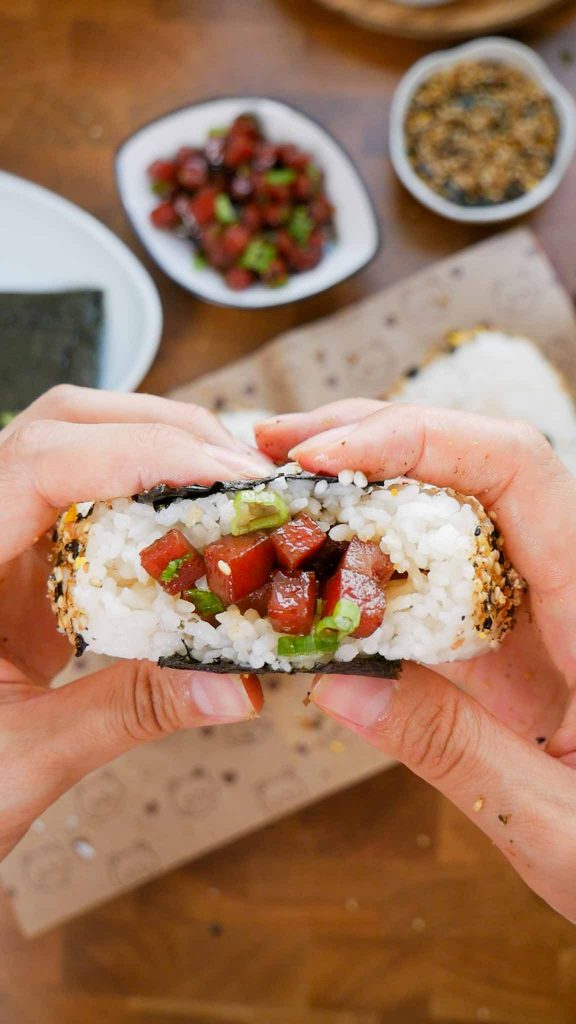
If you’re not familiar with onigiri’s, they are Japanese rice balls that are usually filled with a variety of fillings. While they’re small in size, they’re packed with big flavors! Here are some of my most popular onigiri recipes:
Spicy Creamy Crab Onigiri — Made with pantry staples, the onigiri requires only 5 ingredients, plus salt and pepper! It’s light, bright, zesty, creamy, and spicy.
Mentaiko Onigiri — Mentaiko is a spicy cured pollock roe. It has a deep, rich, umami flavor that is strong in seafood essence but not fishy, and it’s so good with rice!
Mushroom Onigiri — For all my vegetarians out there! This plant-based option for onigiri combines mushrooms with mentsuyu sauce for a soy and umami-rich taste.
Tuna Onigiri — The most popular onigiri flavor in Japan. It’s also the quickest and easiest filling to make! No cooking is required for the filling ingredients.
Salted Salmon Onigiri — Also called shiozake, it’s filled with salted salmon that’s pan-fried and flaked. It’s simple and delicious.

Why you’ll love this recipe
This Spam onigiri is perfect for lazy days when you don’t really feel like cooking or when you’re in need of something quick, delicious, and nourishing. The sweet and savory flavors of the musubi-inspired Spam filling make this irresistibly delicious and addicting. It only requires a few ingredients for the musubi sauce and it pairs so well with Spam. The rice in the onigiri acts as a canvas for the Spam to shine through and there’s no wonder why it’s such an iconic combination. And finally, the nori sheet and optional but highly recommended furikake coating tie everything together.
Now, onigiri is traditionally shaped by hand but to save time, I love using my super cute onigiri mold for convenience. It makes the whole process easier and mess-free! No matter what method you choose to use to shape the onigiri, it’s a great activity to do with a group of people or with kids!
Lastly, Spam onigiri is a great meal prep option because it can be made in advance. After assembling the onigiri, wrap them individually with plastic wrap and keep them in the fridge for up to two days. Right before serving, wrap a roasted seaweed sheet around the onigiri and it’s ready to serve!
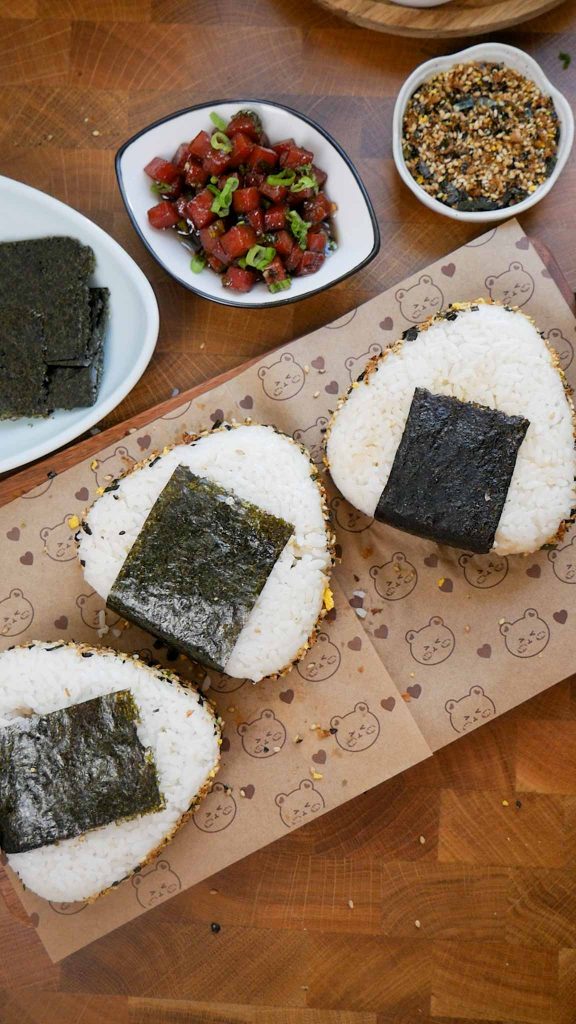
Spam Onigiri Ingredients & Substitutions
Cooked rice: I recommend using sushi rice which is short-grain rice, or medium-grain rice. These two types of rice are starchier, meaning they are sticky and will hold up shape well. Long grain rice has a lower starch content and yields fluffier rice which doesn’t hold shape very well. If you use long-grain rice, the onigiri will fall apart.
Spam: I used the Lite version because I wanted to have more control over the sodium levels, but you can use your favorite variety! When substituting with regular Spam, reduce soy sauce by ½.
Scallion: For added freshness and a slight oniony flavor
Furikake: This is a popular Japanese seasoning made with bonito flakes, sesame seeds, crushed nori, and other seasonings. It is rich in umami flavor. There are many different varieties but my go-to is the bonito & egg flavor.
Roasted seaweed sheets: Onigiri are not complete without a roasted seaweed sheet. It adds an umami sea-like flavor that compliments the rice and Spam deliciously. It also conveniently serves as the handle when eating the onigiri!
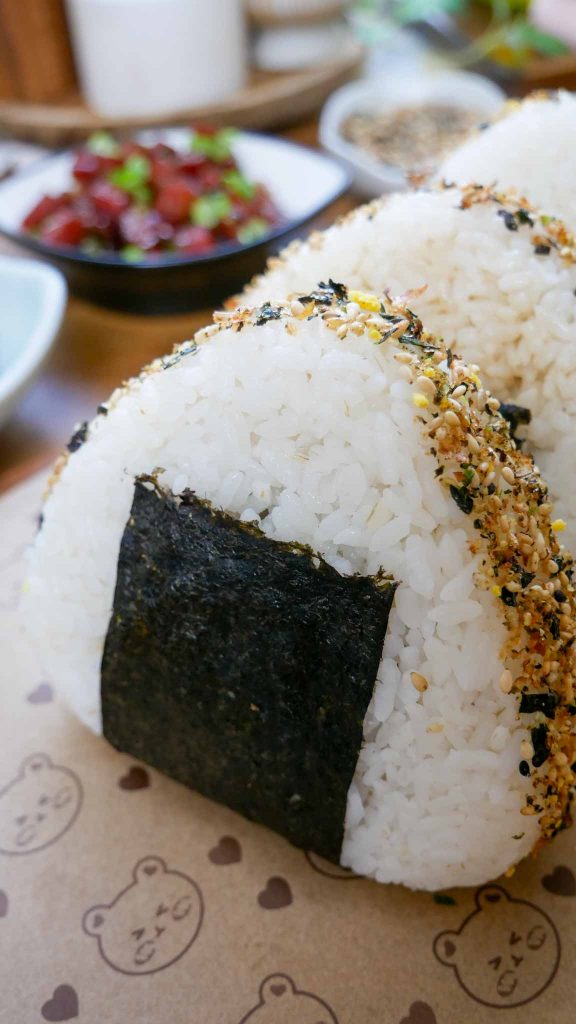
Sauce Ingredients & Substitutions
Sugar: The sweetness helps to balance the saltiness of the Spam. It also makes the sauce thick and sticky.
Soy sauce: Soy sauce is a common ingredient in musubi that adds an extra layer of flavor. Feel free to adjust as needed.
Mirin: Adds a subtle hint of sweetness and acidity that helps to tie the flavors together.
Sesame oil: For a nutty flavor that compliments the Spam and nori

How to prepare Spam Onigiri
Step 1: Dice the Spam.
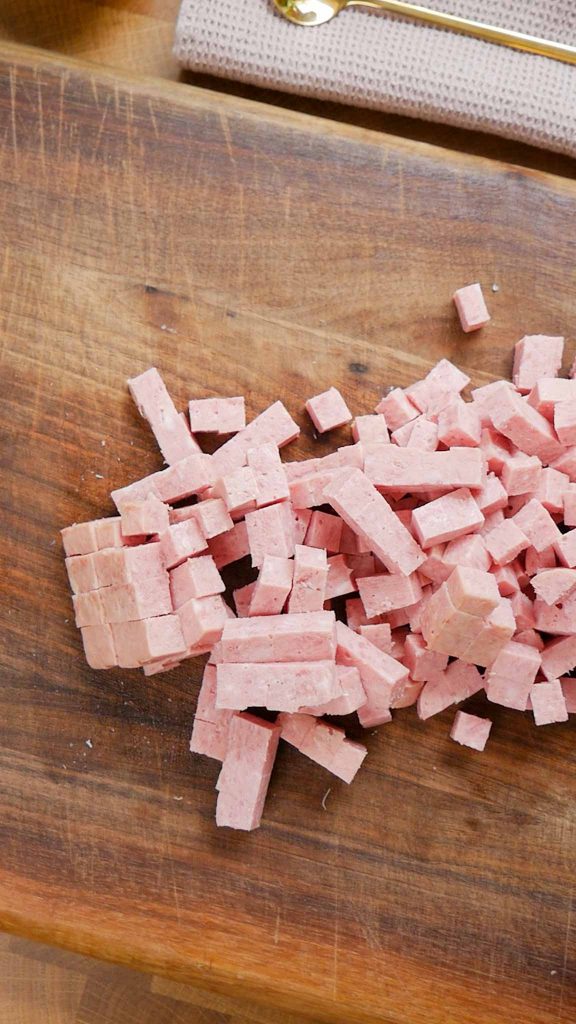
Dice Spam into 1/4 inch thick cubes. Set aside for later.
Step 2: Prepare the sauce.

In a small mixing bowl, combine sugar, soy sauce, mirin, and sesame oil. Mix well.
Step 3: Cook the Spam cubes.
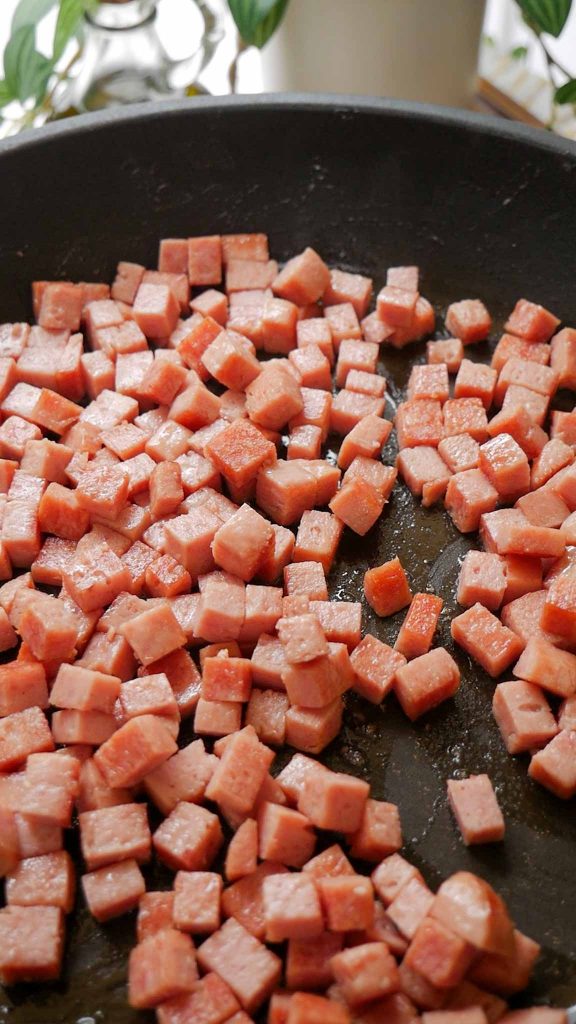
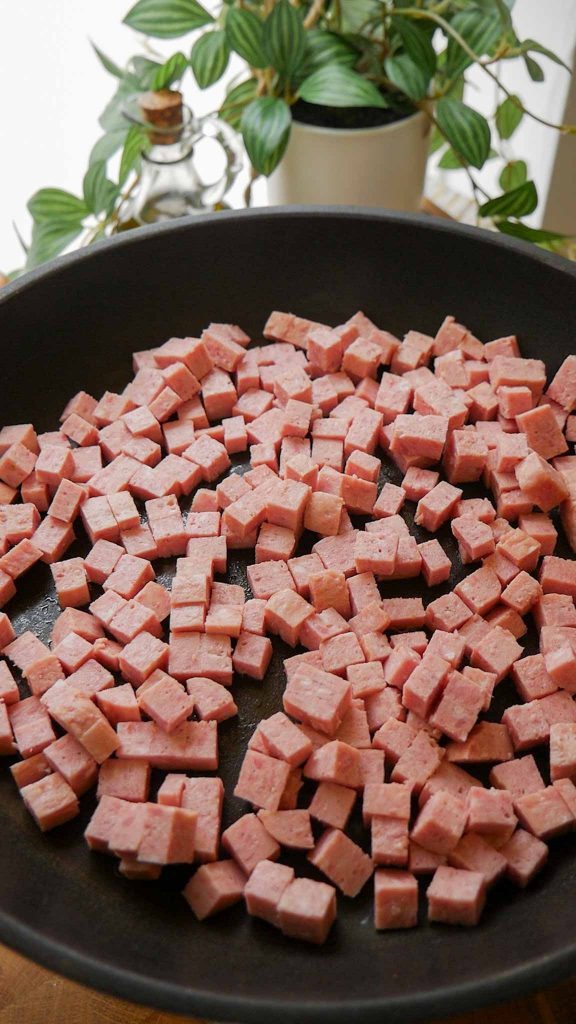
Heat a medium-sized non-stick pan over medium heat. Toss in the Spam and cook until all sides are browned, about 2 to 3 minutes.
Step 4: Add the sauce and reduce.
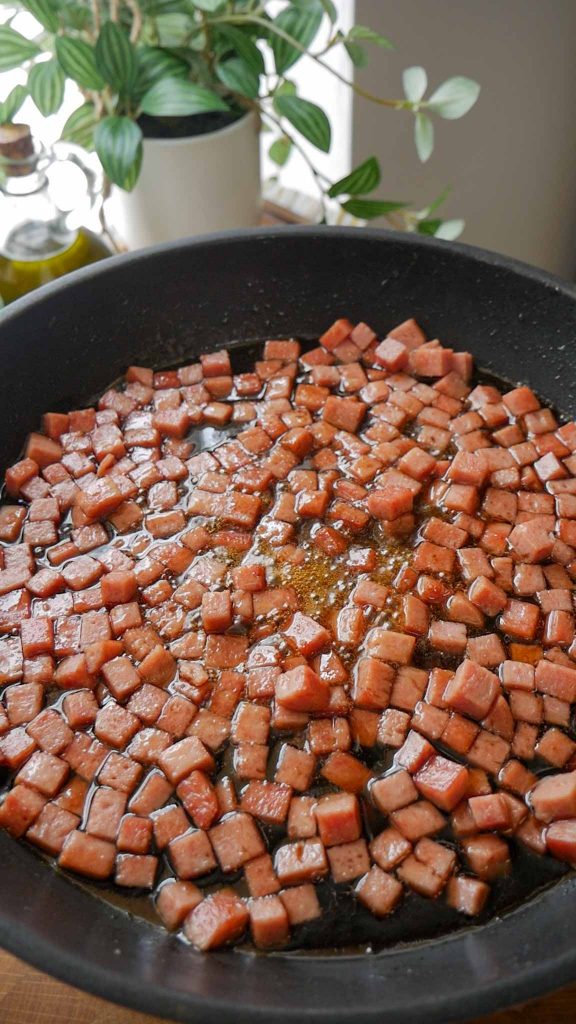
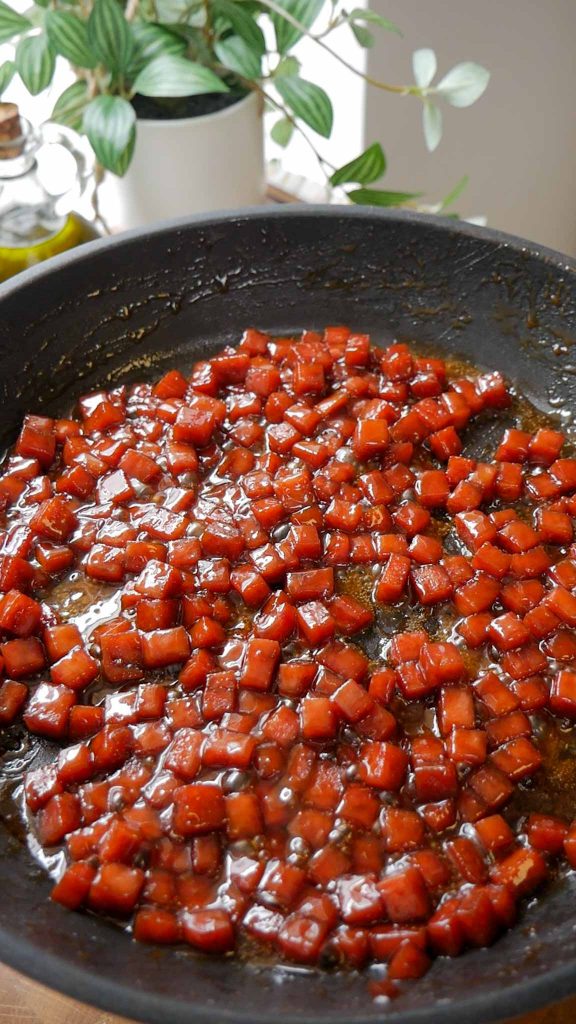
Pour in the sauce from earlier then reduce the heat to medium-low.
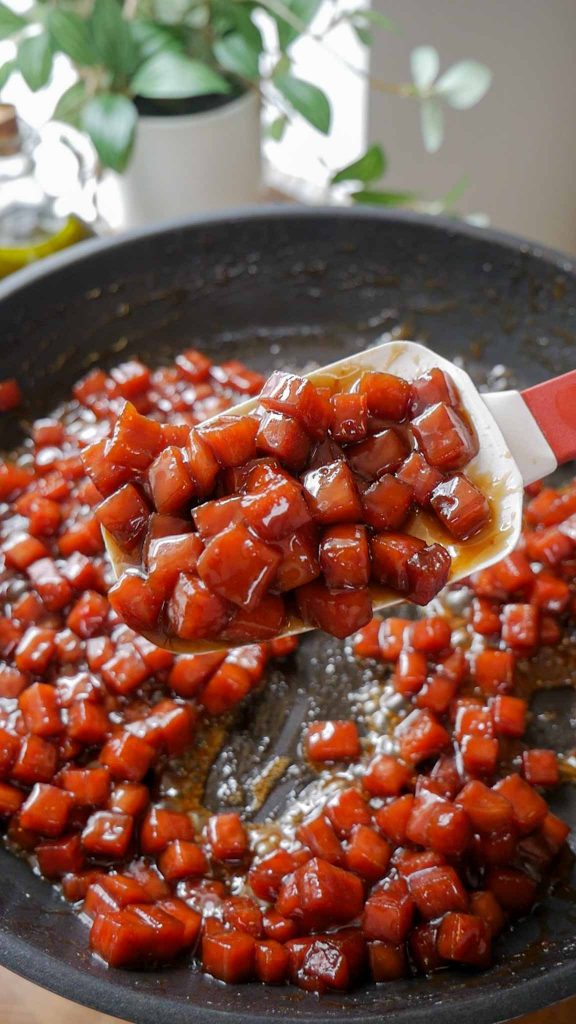
Simmer until most of the sauce has thickened, about 5 minutes. The sauce should be thick and sticky.
Step 5: Add the scallions.
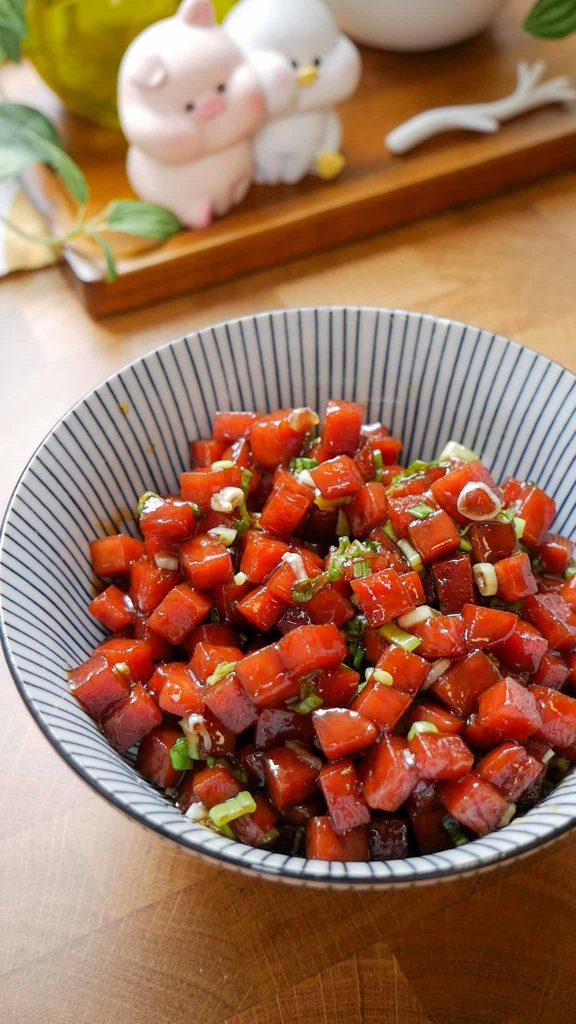
Turn off the heat then add scallions. Mix until well combined then transfer to a bowl.
Step 6: Cool the rice.
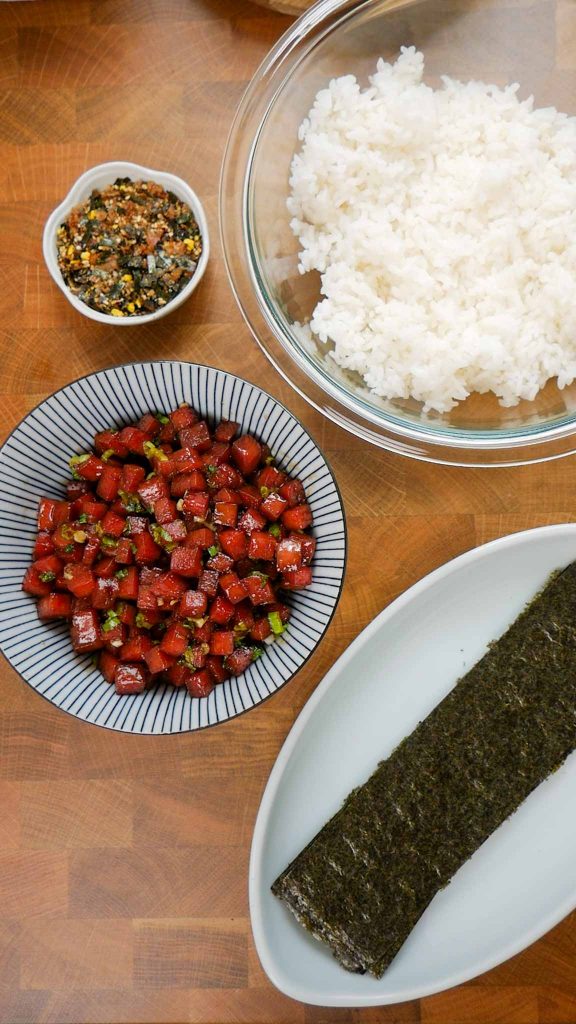
Place the cooked rice into a bowl and allow the rice to cool to the touch.
Step 7: Form the onigiri.
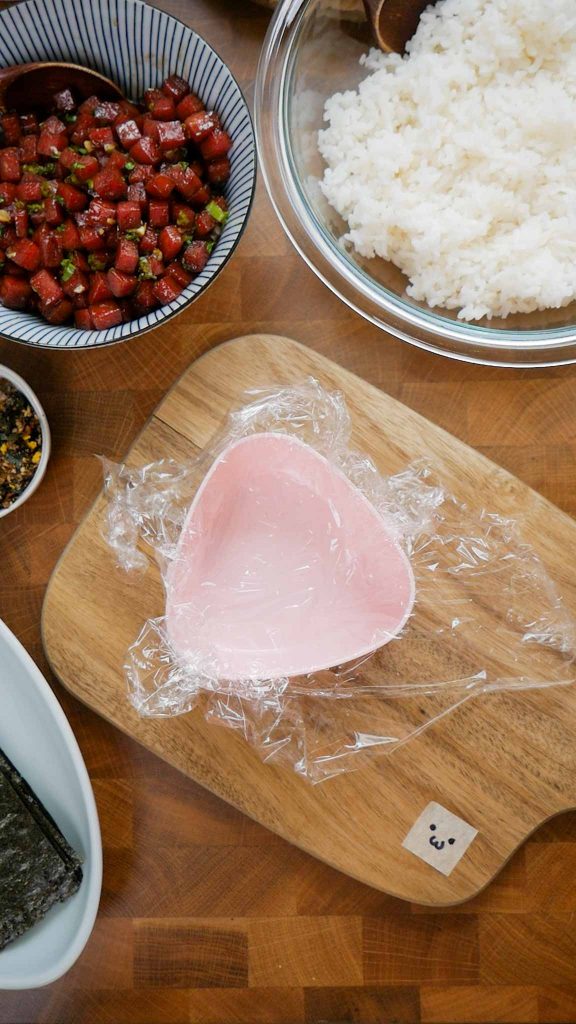
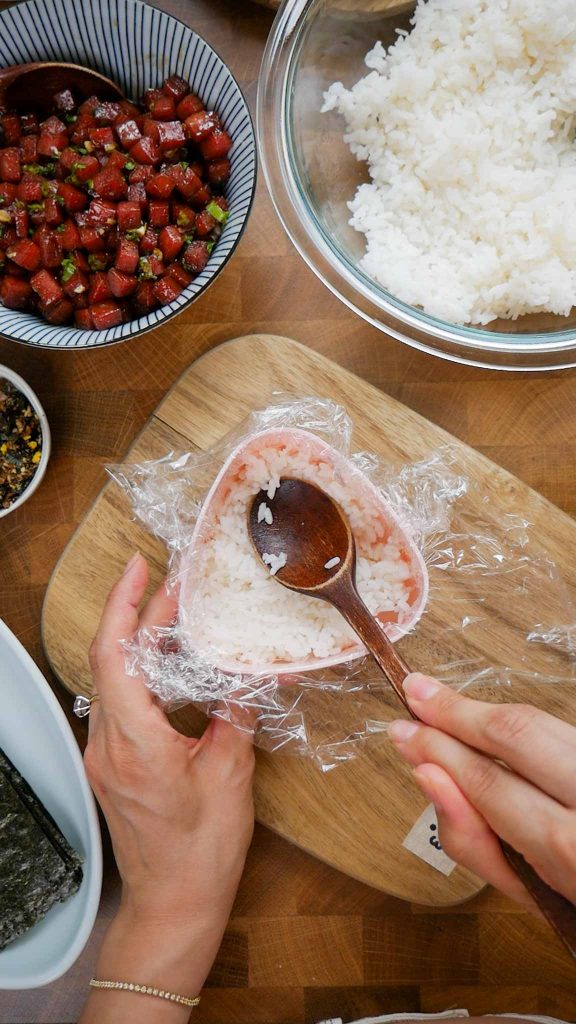
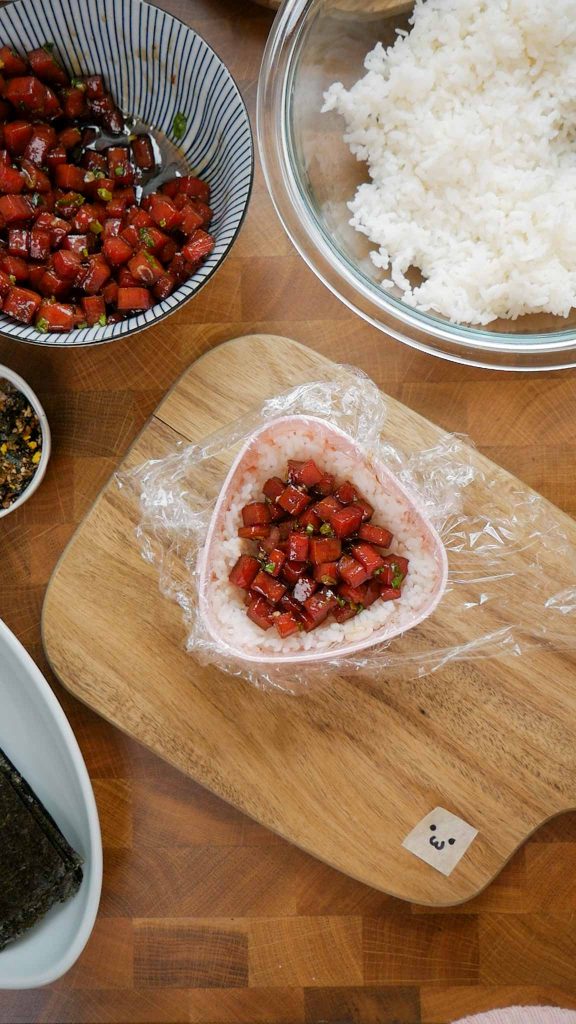
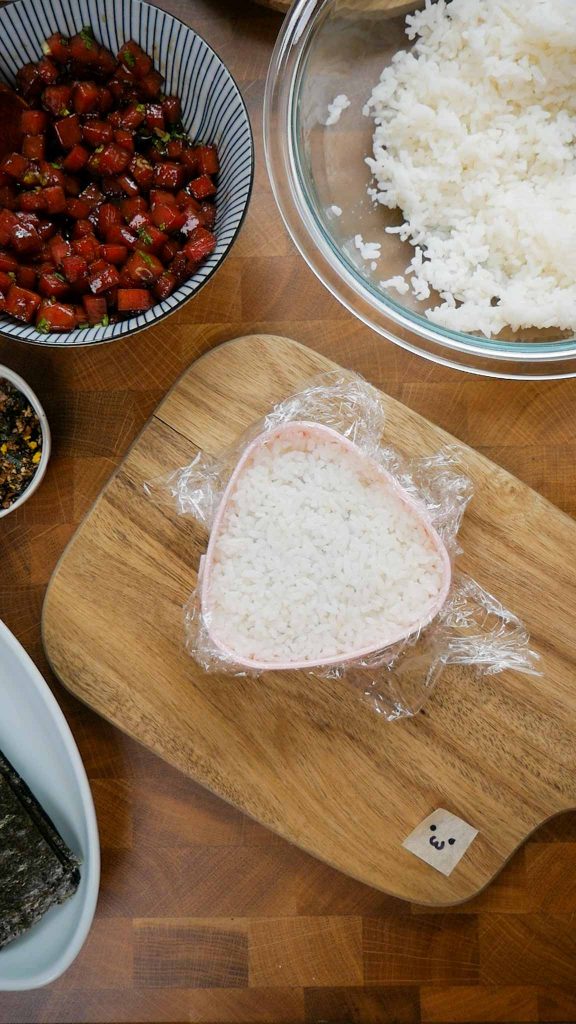
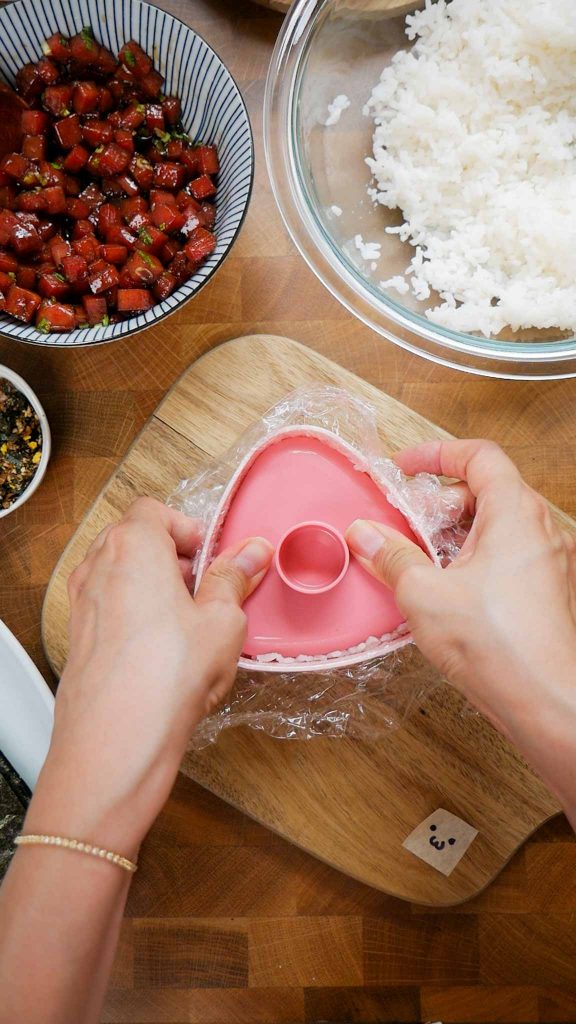
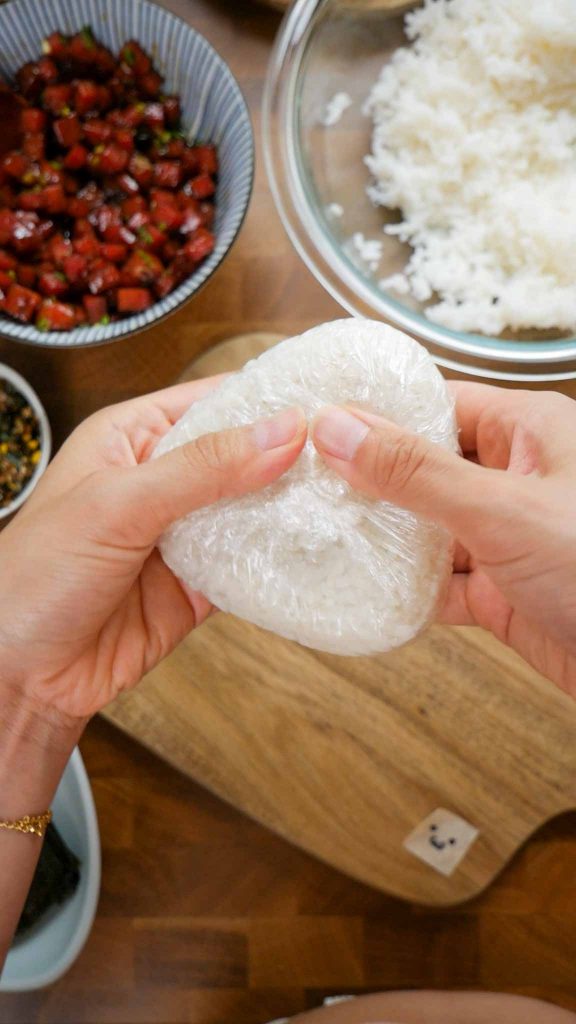
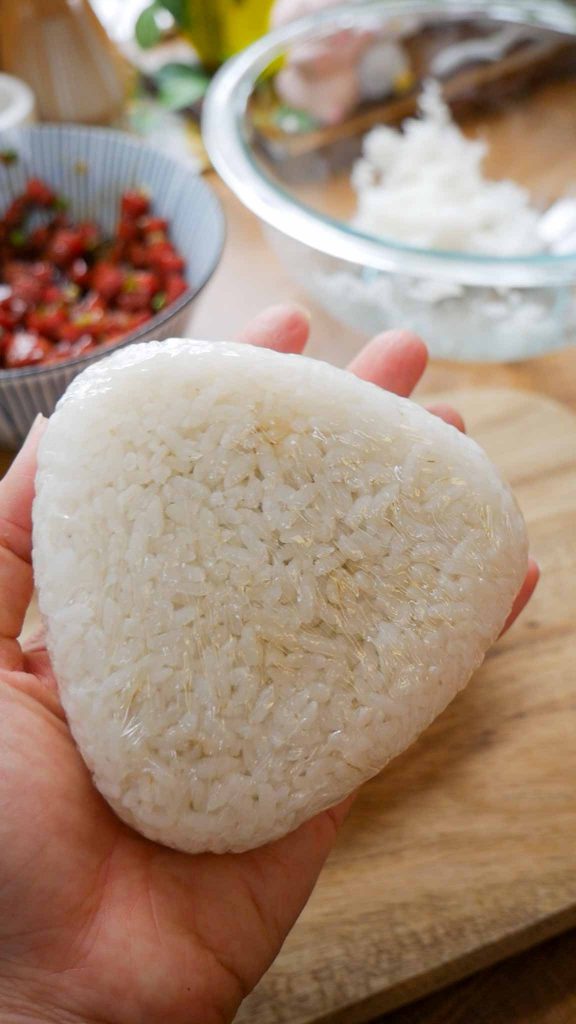
To form the onigiri, you can use a mold like I did or shape it by hand. If using a mold, follow the instructions according to the package.
If shaping by hand, wet both hands and using two fingers, dip it in the bowl with salt. Rub the salt into the palm of your hands until evenly coated. Grab about 1/4 cup rice and flatten it out on the palm of your hand. Place 1 to 2 tablespoons of the Spam mixture in the center. Top with some more rice and press it down so the rice on top sticks to the rice on the bottom. Using your palms, apply pressure and shape the onigiri into a triangle. To create a triangle shape, make the palm of one hand flat and make a 90-degree angle with the other hand. Shape the rice ball using this formation while rotating. Be sure to apply pressure when shaping! This may take some practice and a few tries.
Step 8: Coat with furikake, wrap with seaweed, and serve.
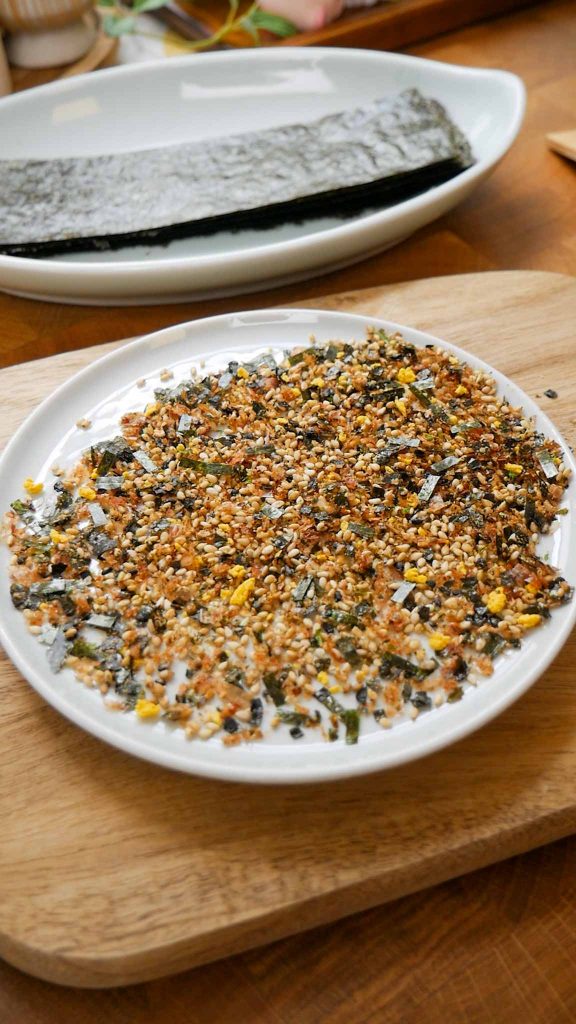
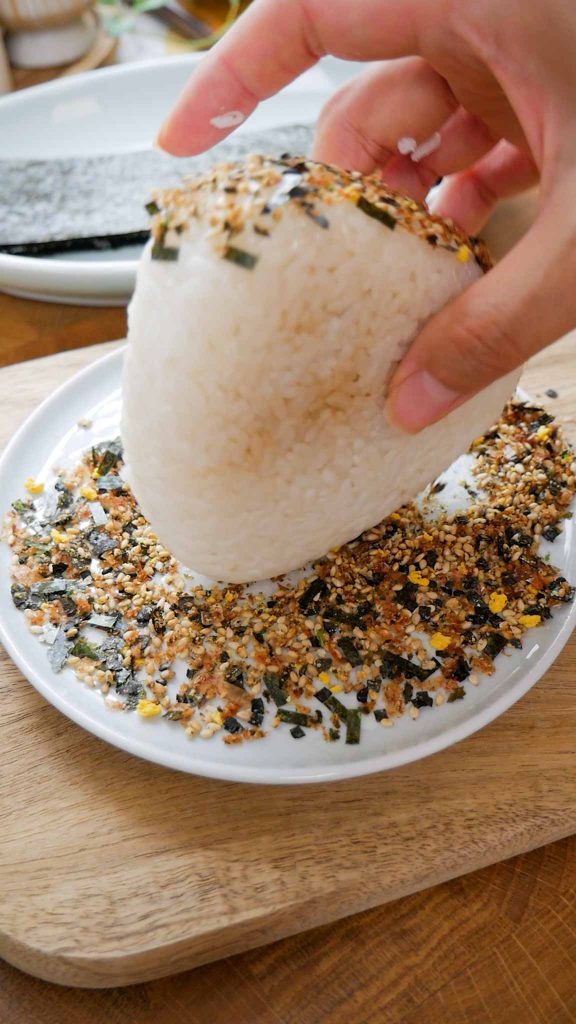
Carefully coat the edges of the onigiri in furikake seasoning.
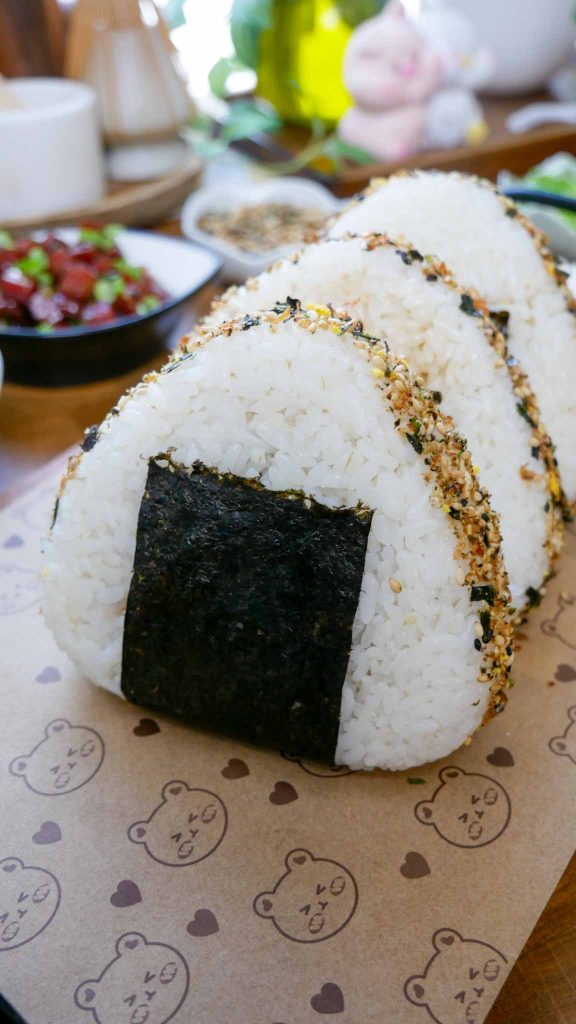
Carefully coat the edges of the onigiri in furikake seasoning. Wrap in a seaweed sheet right before serving and enjoy!
Preparation Tips for Spam Onigiri
Here are some helpful tips for making the best Spam onigiri at home every time:
- It’s important to use the right kind of rice. You want to use one that’s sticky enough to hold the shape which is short-grain or medium-grain rice. DO NOT use long-grain rice like Jasmine or Basmati because they are not as sticky and starchy. The onigiri will fall apart if you use long-grain rice.
- You can customize the filling by adding other ingredients. For instance, you can add a dash of gochugaru or sriracha for some spice, eggs for a heartier filling, or sesame seeds for added texture. Cheese would be delicious, too!
- If shaping the onigiri by hand, make sure to have a bowl of water next to you and wet your hands before shaping to prevent the rice grains from sticking.
- When making onigiri ahead of time, it’s important to wrap them individually with plastic wrap and keep the seaweed sheet separate. Right before serving, wrap the seaweed around the onigiri so that it stays nice and crisp.

Frequently Asked Questions
How do you keep onigiri from falling apart?
It’s important to start with using the right type of rice, which is short-grain or medium-grain rice. These rice varieties are sticky and starchy which helps the onigiri hold shape. When assembling the onigiri, pack them tightly so that the rice grains stick together and hold the filling inside. The together the onigiri is packed, the better!
What kind of rice is used in onigiri?
Onigiri uses sushi rice (also known as short-grain) however medium-grain rice also works too. These types of rice are starchy and therefore when cooked, result in rice that’s quite sticky. Long-grain rice is not ideal as it is fluffy and won’t hold shape.
Is musubi and onigiri the same?
Musubi is a popular food in Hawaii which includes a layer of rice and a slice of seasoned Spam wrapped with a thin layer of seaweed. Musubi is usually served in a rectangular shape and is generally enjoyed as a quick meal or on-the-go snack. The Spam is cooked in a sweet and savory sauce, which is balanced by the rice.
Onigiri, on the other hand, is a popular convenience store food in Japan. It’s a triangular-shaped rice ball that’s filled with a variety of ingredients and served with a seaweed sheet. While both musubi and onigiri include rice and some sort of filling, they are uniquely assembled. Musubi is also typically made with Spam, while onigiri comes in a large variety of fillings.
Is it safe to reheat onigiri?
In Japan, onigiri are available in the refrigerated section of convenience stores like 7-Eleven and they taste just delicious so they can be enjoyed cold. I don’t recommend reheating onigiri for the simple fact that the seaweed will get soggy and the onigiri may fall apart. If you don’t want to eat the onigiri cold, I recommend leaving it out on the counter for an hour so it comes to room temperature.
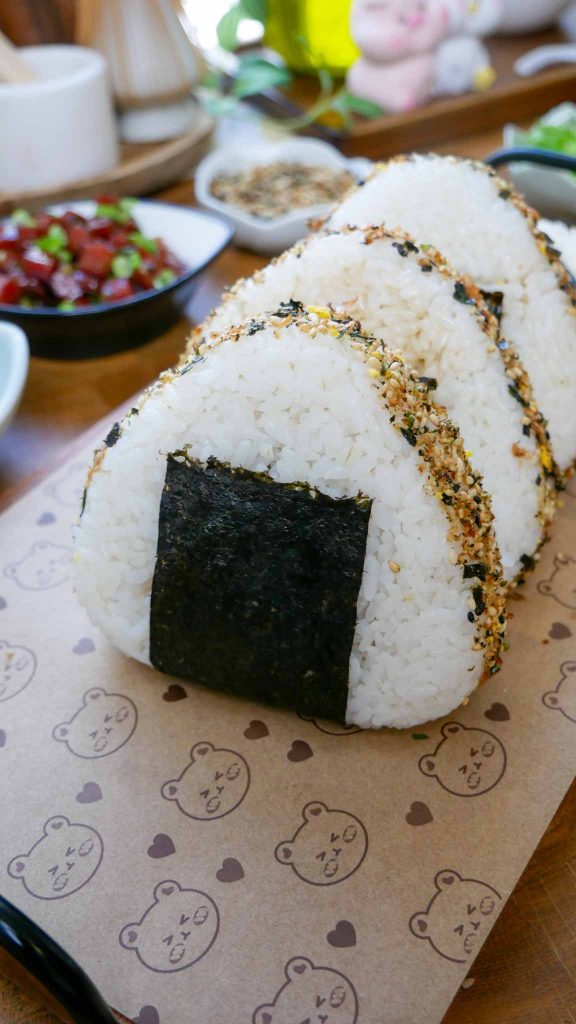
Looking for more easy and delicious Japanese-inspired rice recipes?
Ikura Don — Freshly cooked white rice is topped with soy-marinated ikura, or raw salmon roe, and egg. Each spoonful is an explosion of fresh, savory, and umami goodness!
Spam Rice Balls — Musubi-inspired Spam, eggs, mayo, and rice are put together for a quick and easy meal. Perfect for busy and on-the-go students!
Coco Ichibanya Curry Rice — Here’s my take on the famous Coco Ichibanya’s katsu curry rice! It’s rich and scrumptious and would surely soothe the soul.
Spicy Tuna Salad with Crispy Rice — Here’s a dupe for the viral spicy tuna crispy rice made using canned tuna. It starts with cooked rice fried to a golden brown, then topped with avocado and seasoned tuna!
Japanese Beef Rice Bowl — Japanese-style beef rice bowl or ‘gyudon‘ is a quick, hearty, and satisfying meal that comes together in just 15 minutes. It’s a simple yet satisfying dish that is made of thinly sliced beef and aromatics cooked in a sweet and savory sauce and served over a bowl of steaming rice.
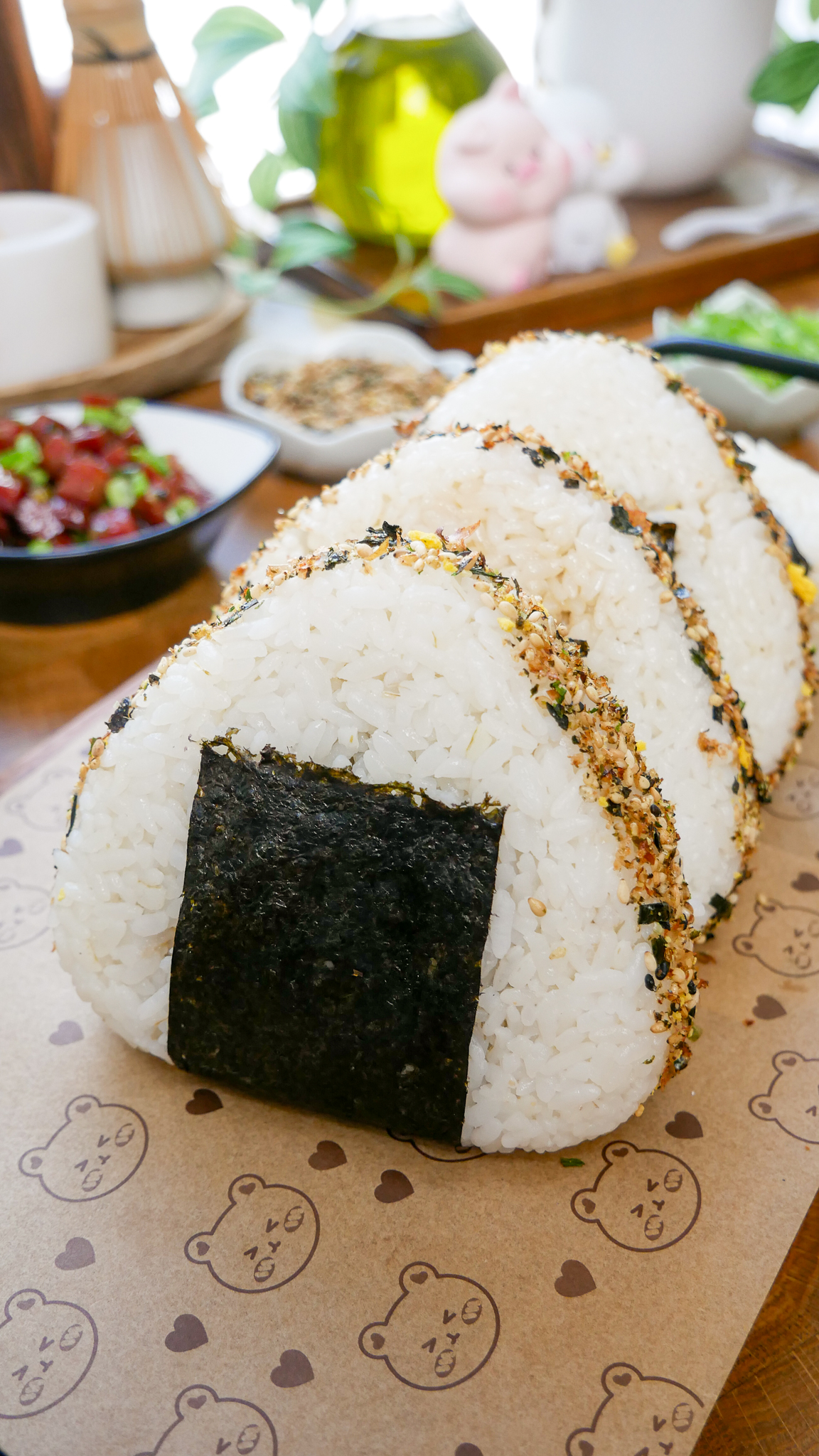
Spam Onigiri Recipe
Ingredients
- 3-4 cups cooked rice short-grain or medium-grain rice
- 1/2 can (170g) Spam Lite diced to 1/4 inch cubes, substitute with regular Spam and reduce soy sauce by 1/2.
- 2 scallion chopped
- 3 tbsp furikake
- 2 roasted seaweed sheets cut into 2 inch strips
Sauce
- 2 tbsp sugar adjust to taste
- 1 tbsp soy sauce adjust to taste
- 2 tbsp mirin
- 2 tsp sesame oil
Instructions
- Dice Spam into 1/4 inch thick cubes. Set aside for later.
- In a small mixing bowl, combine sugar, soy sauce, mirin, and sesame oil. Mix well.
- Heat a medium-sized non-stick pan over medium heat. Toss in the Spam and cook until all sides are browned, about 2 to 3 minutes.
- Pour in the sauce from earlier then reduce the heat to medium-low. Simmer until most of the sauce has thickened, about 5 minutes. The sauce should be thick and sticky.
- Turn off the heat then add scallions. Mix until well combined then transfer to a bowl.
- Place the cooked rice into a bowl and allow the rice to cool to the touch.
- To form the onigiri, you can use a mold like I did or shape it by hand. If using a mold, follow the instructions according to the package.If shaping by hand, wet both hands and using two fingers, dip it in the bowl with salt. Rub the salt into the palm of your hands until evenly coated. Grab about 1/4 cup rice and flatten it out on the palm of your hand. Place 1 to 2 tablespoons of the Spam mixture in the center. Top with some more rice and press it down so the rice on top sticks to the rice on the bottom. Using your palms, apply pressure and shape the onigiri into a triangle. To create a triangle shape, make the palm of one hand flat and make a 90-degree angle with the other hand. Shape the rice ball using this formation while rotating. Be sure to apply pressure when shaping! This may take some practice and a few tries.
- Carefully coat the edges of the onigiri in furikake seasoning. Wrap in a seaweed sheet right before serving and enjoy!